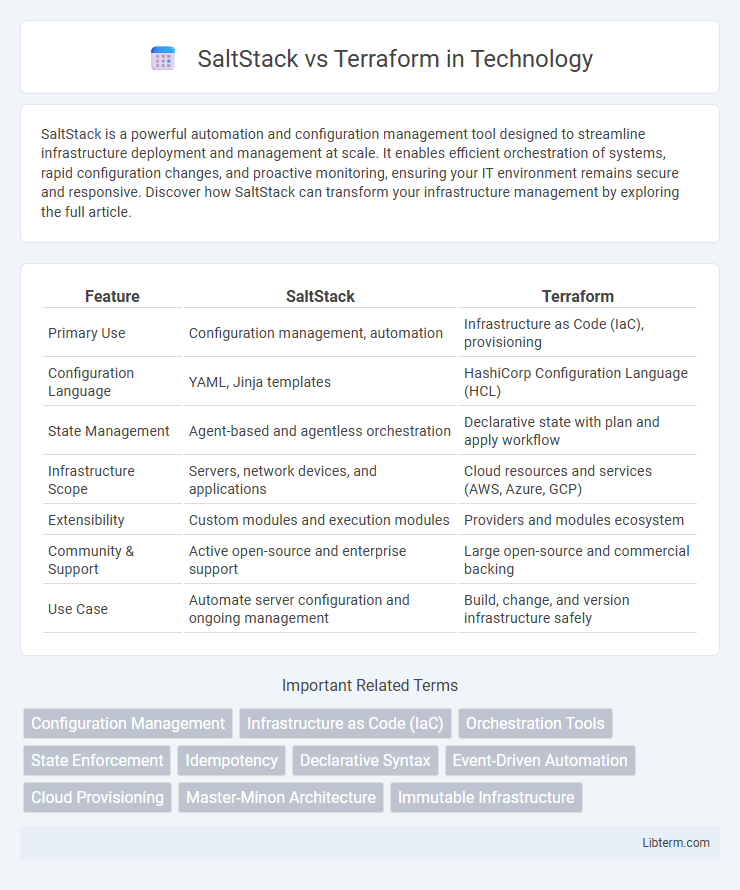SaltStack is a powerful automation and configuration management tool designed to streamline infrastructure deployment and management at scale. It enables efficient orchestration of systems, rapid configuration changes, and proactive monitoring, ensuring your IT environment remains secure and responsive. Discover how SaltStack can transform your infrastructure management by exploring the full article.
Table of Comparison
| Feature | SaltStack | Terraform |
|---|---|---|
| Primary Use | Configuration management, automation | Infrastructure as Code (IaC), provisioning |
| Configuration Language | YAML, Jinja templates | HashiCorp Configuration Language (HCL) |
| State Management | Agent-based and agentless orchestration | Declarative state with plan and apply workflow |
| Infrastructure Scope | Servers, network devices, and applications | Cloud resources and services (AWS, Azure, GCP) |
| Extensibility | Custom modules and execution modules | Providers and modules ecosystem |
| Community & Support | Active open-source and enterprise support | Large open-source and commercial backing |
| Use Case | Automate server configuration and ongoing management | Build, change, and version infrastructure safely |
Introduction to SaltStack and Terraform
SaltStack is an open-source configuration management and automation tool designed for infrastructure orchestration, enabling scalable control over server configurations and deployments. Terraform, developed by HashiCorp, is an infrastructure as code (IaC) tool that automates the provisioning and management of cloud resources across multiple providers using declarative configuration files. Both tools streamline infrastructure management but serve different core functions: SaltStack emphasizes real-time configuration automation, while Terraform focuses on resource provisioning and lifecycle management.
Core Features and Capabilities
SaltStack excels in real-time configuration management, event-driven automation, and remote execution, offering powerful orchestration with a decentralized architecture ideal for large-scale infrastructure. Terraform specializes in infrastructure as code (IaC) for provisioning and managing cloud resources across multiple providers, utilizing a declarative syntax and state management to ensure consistent environment deployments. Both tools support automation but SaltStack emphasizes configuration and system management, while Terraform focuses on cloud infrastructure provisioning and lifecycle management.
Infrastructure as Code: Approach Comparison
SaltStack uses a state-driven approach for Infrastructure as Code, emphasizing configuration management and automation through declarative YAML-based states, while Terraform employs a declarative, immutable infrastructure model primarily focused on provisioning and managing cloud resources via its HashiCorp Configuration Language (HCL). SaltStack excels in continuous configuration enforcement and real-time orchestration across heterogeneous environments, whereas Terraform offers robust infrastructure lifecycle management with plan and apply phases that ensure predictable resource changes. Terraform's provider ecosystem supports extensive cloud platform integrations, contrasting with SaltStack's tighter integration with system-level configuration and event-driven automation.
Configuration Management vs. Provisioning
SaltStack excels in configuration management by enabling real-time infrastructure automation, state enforcement, and detailed system configuration across diverse environments. Terraform specializes in provisioning by efficiently creating, modifying, and versioning cloud infrastructure using declarative configuration files for multiple providers. Combining SaltStack's configuration management with Terraform's provisioning capabilities allows seamless infrastructure deployment followed by continuous configuration enforcement.
Ecosystem and Community Support
SaltStack and Terraform both offer robust ecosystems, but Terraform boasts a larger, more active community with extensive provider plugins across multiple cloud platforms, enabling seamless infrastructure as code management. SaltStack's ecosystem excels in configuration management and automation, supported by a dedicated user base and strong integration with event-driven orchestration tools. Terraform's broader community contributions and comprehensive documentation make it a preferred choice for scalable infrastructure provisioning in diverse cloud environments.
Integration and Extensibility
SaltStack offers robust integration capabilities with existing IT infrastructure through its event-driven automation and dynamic inventory system, enabling real-time orchestration across diverse environments. Terraform excels in extensibility by supporting a vast library of providers and modules that facilitate infrastructure as code across multiple cloud platforms, ensuring seamless resource management. Both tools support API-driven workflows, but SaltStack's modular architecture prioritizes configuration management while Terraform emphasizes declarative provisioning and state management.
Scalability and Performance
SaltStack offers high scalability through its event-driven architecture and asynchronous communication, enabling efficient management of thousands of nodes with minimal latency. Terraform excels in performance by leveraging declarative infrastructure as code to orchestrate cloud resources rapidly and manage dependencies effectively across diverse environments. Both tools support large-scale deployments, but SaltStack is often favored for real-time configuration management, while Terraform provides optimized provisioning and version control for infrastructure changes.
Security and Compliance
SaltStack offers granular security controls and compliance automation through role-based access control (RBAC) and event-driven compliance enforcement, ensuring infrastructure stays aligned with security policies. Terraform emphasizes secure infrastructure provisioning with state file encryption and integration with secrets management tools like HashiCorp Vault to protect sensitive data. Both tools support policy-as-code frameworks, but SaltStack provides deeper compliance auditing capabilities, making it ideal for environments with stringent regulatory requirements.
Use Cases and Industry Adoption
SaltStack excels in real-time infrastructure automation and configuration management, making it ideal for IT operations teams managing large-scale server environments and continuous deployment pipelines. Terraform is widely adopted for multi-cloud infrastructure provisioning and orchestration, favored by DevOps engineers for its infrastructure-as-code capabilities across AWS, Azure, and Google Cloud platforms. The finance and telecommunications sectors heavily utilize SaltStack for compliance-driven configuration tasks, while technology companies and cloud service providers prefer Terraform for scalable infrastructure provisioning and environment consistency.
Choosing the Right Tool for Your Needs
SaltStack excels in real-time configuration management and remote execution, making it ideal for dynamic infrastructure requiring frequent updates and automation. Terraform specializes in infrastructure as code with a strong emphasis on provisioning cloud resources and managing infrastructure lifecycle across multiple providers. Choosing between SaltStack and Terraform depends on whether your priority is granular configuration control and automation (SaltStack) or robust infrastructure provisioning and multi-cloud management (Terraform).
SaltStack Infographic

 libterm.com
libterm.com